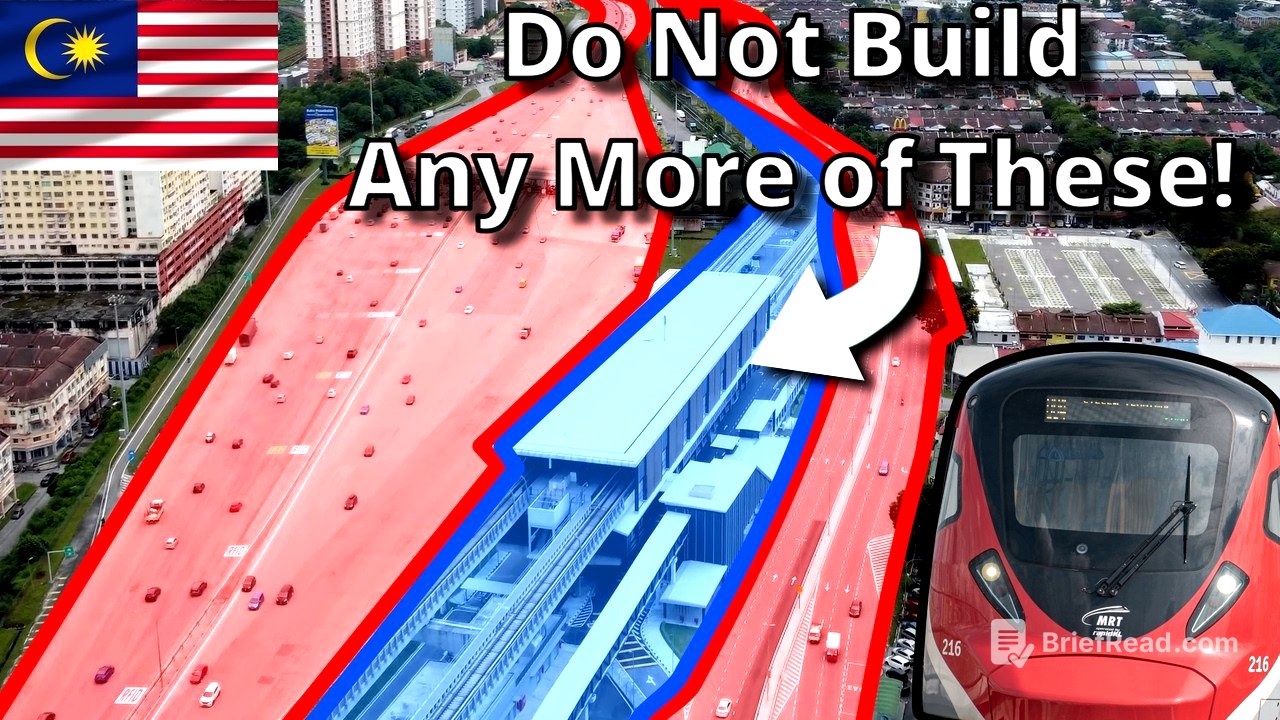TLDR;
This video explores the reasons behind the low ridership on Kuala Lumpur's new MRT lines despite their modern infrastructure. The video identifies three main reasons: poor network density, operational issues, and inaccessible stations. It then provides recommendations for improving the situation, focusing on urban planning, policy and governance, and specific examples of how to improve the Putrajaya Line.
- Key takeaways:
- KL's MRT lines are underutilized due to poor network density, operational issues, and inaccessible stations.
- The video proposes solutions like increasing population density around stations, improving pedestrian and cycling infrastructure, expanding the feeder bus network, and enforcing traffic rules.
- Specific examples are given for improving the Putrajaya Line, highlighting the potential for small investments to significantly boost ridership.
Intro [0:00]
The video begins by highlighting Kuala Lumpur's traffic congestion problem and the city's recent investment in modern MRT lines. Despite these investments, ridership remains significantly lower than projected. The video aims to explore the reasons behind this and propose solutions to improve the situation.
Reason 1: Network Density [0:48]
The video argues that the low ridership is partly due to the lack of network density in certain areas. Many neighborhoods are poorly served by rail transit, requiring commuters to use buses or ride-hailing services to reach the station. This makes public transport less appealing, especially when it takes longer than driving. The video emphasizes the need for politicians to prioritize expanding the public transport network.
Reason 2: Operational Issues [2:19]
The video discusses operational issues that negatively impact the user experience. Examples include frequent train breakdowns, lack of communication during service interruptions, and lengthy service outages. These issues contribute to commuter frustration and discourage them from using the MRT.
Reason 3: Inaccessible Stations [3:26]
The video highlights the poor location of many MRT stations, often built along highways or in isolated areas rather than where people live and work. This makes it difficult for residents to access the stations without a car. The video also criticizes the lack of pedestrian infrastructure, making walking or cycling to the station unsafe and inconvenient.
Recommendations - Urban Planning [7:12]
The video proposes increasing population density around stations by redeveloping land near MRT stations and creating transit-oriented neighborhoods. This would encourage more people to live near stations and rely on public transport. The video also emphasizes the importance of safe pedestrian and cycling infrastructure, advocating for level crossings over bridges and the removal of barriers like highways.
Recommendations - Policy and Governance [12:37]
The video calls for a shift in policy and governance towards prioritizing public transport over private vehicles. This includes expanding the feeder bus network, enforcing traffic rules, and phasing out petrol subsidies. The video also emphasizes the need for dedicated leadership to drive the transition to a transit-oriented city.
How to improve Putrajaya Line [15:02]
The video focuses on specific recommendations for improving the Putrajaya Line. It analyzes each station to identify accessibility limitations and proposes small investments that could significantly boost ridership. The video provides two examples:
Example 1 - Kuchai [15:26]
The video highlights the Kuchai station, which is located near a new development in Taman Desa. However, a highway prevents convenient access to the station. The video suggests building a pedestrian bridge and tunnels to improve accessibility for the estimated 15,000 residents in the area.
Example 2 - Sri Delima [16:04]
The video discusses the Sri Delima station, which is difficult to reach due to poor pedestrian infrastructure. The video proposes a pedestrian bridge over the lake to improve access for residents of the Lakecity development.
Summary [16:55]
The video concludes by summarizing its key points and emphasizing the need for a shift towards a transit-oriented city. It encourages viewers to visit the "KL Metroscape" website for a map with improvement proposals. The video argues that small investments in pedestrian infrastructure and policy changes can significantly improve public transport usage and reduce traffic congestion in Kuala Lumpur.
